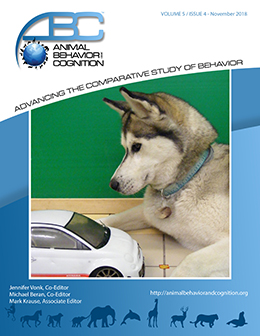Vol 5, Issue 4, November 2018
Inferring Causal Relationships in Zebrafish-Robot Interactions Through Transfer Entropy: A Small Lure to Catch a Big Fish
Citation
Porfiri, M. (2018). Inferring causal relationships in zebrafish-robot interactions through transfer entropy: a small lure to catch a big fish. Animal Behavior and Cognition, 5(4), 341-367. https://doi.org/10.26451/abc.05.04.03.2018
Abstract
In the field of animal behavior, effective methods to apprehend causal relationships that underlie the interactions between animals are in dire need. How to identify a leader in a group of social animals or quantify the mutual response of predator and prey are exemplary questions that would benefit from an improved understanding of causality. Information theory offers a potent framework to objectively infer cause-and-effect relationships from raw experimental data, in the form of behavioral observations or individual trajectory tracks. In this targeted review, we summarize recent advances in the application of the information-theoretic concept of transfer entropy to animal interactions. First, we offer an introduction to the theory of transfer entropy, keeping a balance between fundamentals and practical implementation. Then, we focus on animal-robot experiments as a means for the validation of the use of transfer entropy to measure causal relationships. We explore a test battery of robotics-based protocols designed for studying zebrafish social behavior and fear response. Grounded in experimental evidence, we demonstrate the potential of transfer entropy to assist in the detection and quantification of causal relationships in animal interactions. The proposed robotics-based platforms offer versatile, controllable, and customizable stimuli to generate a priori known cause-and-effect relationships, which would not be feasible with live stimuli. We conclude the paper with an outlook on possible applications of transfer entropy to study group behavior and clarify the determinants of leadership in social animals.
Keywords
Ethorobotics, Fear response, Information theory, Robotics, Social behavior
